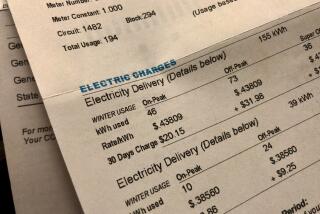Utility Bills Fast Becoming Utility Billboards : Telephone Companies Are Going Commercial
- Share via
SAN DIEGO — Although consumers regularly complain that monthly telephone and power bills are too high, they can’t always complain that the bills are dull.
Billing envelopes, which once chronicled long-distance charges and kilowatt-hour usage, have lately been carrying some decidedly non-utility messages. A growing number of envelopes contain sales pitches for an ever-widening range of consumer goods and services.
Last August, Pacific Bell began inserting paid advertisements from long-distance carriers into envelopes containing long-distance and local service charge sheets. MCI and Express Tel have paid for inserts, and Pacific Bell managers are “discussing . . . what the future of billing advertising is,” according to a spokeswoman.
That “future” began to unfold at least three years ago, when a handful of telephone companies “realized that a certain amount of weight per envelope was being wasted,” according to General Telephone of Florida spokesman Tony Hamilton.
Telephone companies, which have long included regulatory material in their mailings, realized that there was money to be made--as long as the added advertising material didn’t generate a higher postal charge.
Telephone customers in the Tampa area have received inserts from a drugstore optical department, insurance firms and various kitchenware manufacturers.
Although General Telephone’s insert program has been limited during the many months when its envelopes carry Florida Public Service Commission notices, it has produced $150,000 in income in the last three years.
The move to turn billing envelopes into profit centers began with “divestiture and people (subsequently) going out to find other (ways) to create new revenue streams,” according to Bob Lauman, who operates Southwestern Bell Telephone’s billing insert program in a five-state region.
Plenty of Bills
“We realized that one thing (Southwestern Bell does) better than anyone else is send out about 9.2 million bills per month,” Lauman said. “They’re all mailed first class, they’re all opened, they all get read and, my God, just about all of them are paid.”
Southwestern Bell Telephone cautiously tested the insert waters in late 1984 with a Wall Street Journal subscription solicitation.
“We’re operating in the conservative Midwest area, and you don’t want to go out and throw (customers) some girlie magazine (solicitation),” Lauman said. “Our whole intent is not to tarnish our particular image, so we’re obviously not going to (allow) inserts with politics, religion, sex (or) games of chance.”
Hamilton said: “We do have to be careful about what advertising we accept because (consumers assume) that if the telephone company has put it in their bill, the telephone company must endorse it.”
Southwestern Bell relies on an insert advertising company to determine which advertisements are suitable for its customers’ billing envelopes. “We do research on these companies. If it’s an insurance company, we’ll check with the insurance commissions. If it’s a private company, we’ll call the Better Business Bureau,” Lauman said. “If we can’t get some kind of rating on them, we won’t allow them to go into our envelopes.”
To keep the envelopes looking “clean,” Southwestern Bell has imposed a limit of one insert per monthly billing. “We don’t want it to look like some kind of value pack,” Lauman said.
Southwestern Bell’s advertising insert program is expected to produce a $100,000 net profit during the first quarter of 1986, Lauman said.
Although that income stream pales in comparison to telephone operations, telephone companies have been moving slowly in order in order to gauge customer reaction to the discovery that the phone bill contains someone else’s paid advertising.
“Although we’ve completed some (favorable) economic analysis and see it as a viable opportunity, we’re more concerned about consumer reaction,” said David Swan, a district staff manager with Bell Atlantic, which has been evaluating results of an insert experiment with customers of its New Jersey Bell operating subsidiary.
Direct-mail inserts in general are a “very tricky market . . . (because) there are lots of different places where advertisers can stuff there ads, and that makes it a very topsy-turvy market,” Lauman said.
Use ZIP Codes
Southwestern Bell has been refining its mailing capabilities in order to attract smaller advertisers who likely would be overwhelmed by a response generated through a mailing to its 9.2 million regional customers, or even a mailing just to residents of a single state. Consequently, Southwestern Bell hopes to offer future mailings broken out by ZIP codes, Lauman said.
Pacific Bell has gone a step further, offering to mail by area codes or prefixes (the first three numbers in a seven-digit phone number).
Pacific Bell regularly prints and mails long-distance bills for a handful of long-distance companies. It offers myriad insert advertising combinations: it will stuff pre-printed inserts or add advertising directly to the long-distance bills that it is preparing for long-distance companies.
For $21,000, Pacific Bell will insert 250,000 pre-printed advertisements weighing less than one-tenth of an ounce.
Unlike their recently deregulated communications industry counterparts, the still-regulated power companies have shied away from including paid advertising in their billing inserts.
“We haven’t done it, although it does come up once in a while” in discussions about possible new revenue streams, a Southern California Edison spokesman said.
“There’s not a lot of discussion about that here,” said Dick Nelson, a Los Angeles Department of Water & Power spokesman. “Our billing envelopes are generally filled up to capacity with information about droughts, the energy crisis and conservation. Plus we’re a municipal agency, which makes a difference.”
Potential Gold Mine
Those utilities that are intent upon expanding their insert programs, though, find it easy to do. They merely stack the approved inserts into their inserting machines. “What you’re ultimately looking at,” Lauman said, “is a low-cost, no-risk, high-opportunity program.”
However, an even stronger moneymaker in the utility industry could be making utility customer lists available to qualified customers.
“In all honesty (renting out lists) can be far more profitable . . . than inserts,” said Lauman, who added that telephone companies have lists that “no one else has.”
For example, telephone companies can lure advertisers with continually updated lists of consumers who have moved to new houses and initiated telephone services.
A list-rental business created last summer by Ameritech subsidiaries Illinois and Indiana Bell has attracted “lots of interest” from advertisers, according to Kathy Whalen, a product director of Ameritech’s lists and number services operation.
Found Cumbersome
Telephone companies have long made customer information available in directories. Advertisers, however, have found them cumbersome. “For many years, direct marketers have come to us and asked for information in a more easily used fashion,” said Whalen.
The two phone companies responded to that growing demand with a service that makes telephone directory information available on computer-generated mailing labels.
Not surprisingly, some state utility commissions frown on the growing move to use billing envelopes and customer lists to generate additional revenue. Although the California Public Utilities Commission has no regulations prohibiting advertising inserts, commissioners rely upon an unwritten “policy” that limits envelope inserts.
“Our main interest is that the customer pays his bill and the utility gets its revenues,” a spokesman said. “If the customer buys a television set because of some advertising in the bill, he might withhold payment (for utility service).”
More to Read
Inside the business of entertainment
The Wide Shot brings you news, analysis and insights on everything from streaming wars to production — and what it all means for the future.
You may occasionally receive promotional content from the Los Angeles Times.










